It’s been official for months now – California again is facing water crisis. Unusually dry and hot weather had eroded our priceless Sierra snowpack, the supply of much of our water. Our local reservoirs have been low for years now. In addition, water demand in beautiful state is growing each year and our sources of water are drying up.
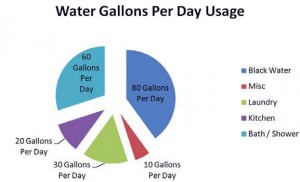 Climate change models demonstrate that California will become a much drier place in our lifetimes. Not only precipitation will likely decrease, but our precious Sierra snowpack is expected to shrink and leave of only with 10% of its current capacity.
Climate change models demonstrate that California will become a much drier place in our lifetimes. Not only precipitation will likely decrease, but our precious Sierra snowpack is expected to shrink and leave of only with 10% of its current capacity.
Even more interesting, according to the California Energy Commission, 20% of our state’s electricity is used for the treatment and pumping of water. Groundwater pumping has greatly shrunk our underground aquifers. Parts of the San Joaquin Valley has now seen soil level drop 50’ from the removal of groundwater. Every single river in California has been dammed, wiping out fish populations, including endangered Chinook salmon. Two out of five most endangered rivers in the U.S. are in California.
Let’s face it; this is not our grandkid’s head ache. Very soon water will become a treasured commodity. Sadly, you’d never know it by the way we are dumping it down the drain. A traditional home has potable water piped in from a local water supplier. Amazingly, one half of this water is used for irrigation, where potable water is absolutely unnecessary. Almost all the remainder is used for non-potable water needs in the house, where it is then flushed down the drain to our local sewage treatment plant.
Now that sewage plant spends an enormous amount of time, money and energy treating this so called “greywater” like raw sewage. This makes no sense, does it?
Here are two ways to re-use water already available to us.
Diverting Greywater for Re-use
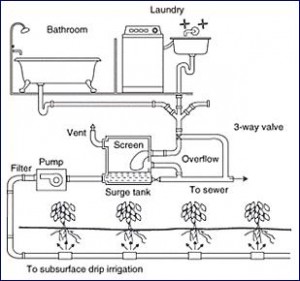 Make a greywater system by diverting water from sinks, showers and laundry to your landscaping needs. Majority of conservation minded folks simply use a plain pipe or hose for landscaping, wherever water is needed. The addition of a mulch and /or gravel filter, often planted with grasses, creates a very robust and clean system. Regrettably, California’s greywater regulations are backward, excessively fearful of some remote chance of spreading pathogens. Profuse amounts of research has shown that sponges, keyboards, doorknobs, and other people are the most likely sources of most contagions. In fact, there has never been a documented illness in California from greywater. As a result of this however, virtually all greywater systems are done without permits. Luckily, acknowledging the state’s outdated perception of greywater, local jurisdictions are increasingly passing regulations to make it simpler and cheaper to install legal greywater systems.
Make a greywater system by diverting water from sinks, showers and laundry to your landscaping needs. Majority of conservation minded folks simply use a plain pipe or hose for landscaping, wherever water is needed. The addition of a mulch and /or gravel filter, often planted with grasses, creates a very robust and clean system. Regrettably, California’s greywater regulations are backward, excessively fearful of some remote chance of spreading pathogens. Profuse amounts of research has shown that sponges, keyboards, doorknobs, and other people are the most likely sources of most contagions. In fact, there has never been a documented illness in California from greywater. As a result of this however, virtually all greywater systems are done without permits. Luckily, acknowledging the state’s outdated perception of greywater, local jurisdictions are increasingly passing regulations to make it simpler and cheaper to install legal greywater systems.
Rainwater Harvesting
Rainwater has been coming down from heavens for as long as this planet has existed. Yes we have less of it here in California than in some other states but that makes capturing of this water even more important.
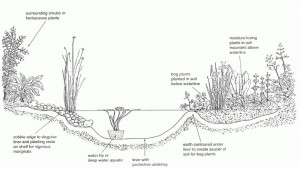 This is super simple. Rainwater from your roof can be harvested and reused for landscaping needs by diverting it from your downspouts into a storage container. Rain barrels and other relatively small storage devices can be utilized, but they do tend to fill and be depleted quickly as the average roof diverts 10-15,000 gallons of rainwater a year. The best way is to install large above-ground or underground cisterns that hold about as much water as your roof will be willing to deliver. This water can then be used in the dry season with the use of a simple filter and a solar powered pump.
This is super simple. Rainwater from your roof can be harvested and reused for landscaping needs by diverting it from your downspouts into a storage container. Rain barrels and other relatively small storage devices can be utilized, but they do tend to fill and be depleted quickly as the average roof diverts 10-15,000 gallons of rainwater a year. The best way is to install large above-ground or underground cisterns that hold about as much water as your roof will be willing to deliver. This water can then be used in the dry season with the use of a simple filter and a solar powered pump.
A different way to capture rainwater would be to build a nice pond for storage. A clay bottomed vernal pond can be a beautiful touch to your yard and act as a wetland habitat for birds or even a few fishes. If you really want to create a visually pleasing space then use some wetland native plants. This will really spruce up your yard and get your neighbors talking.
Water is the ultimate source of life; don’t let it slip through your fingers.
Post Author: Forrest Linebarger is the CEO of VOX Design Group Inc. based in Mountain View, which specializes in green building.
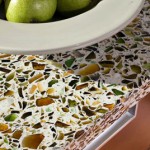 Countertops: Say Goodbye to Granite and Say Hello to… Recycled Glass?
Countertops: Say Goodbye to Granite and Say Hello to… Recycled Glass? What’s the Big Deal about Home Performance Analysis?
What’s the Big Deal about Home Performance Analysis?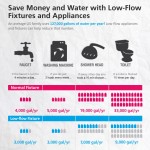 How Much Water is Your Home Really Wasting?
How Much Water is Your Home Really Wasting?
Great Article!!!! However, there is a third way to use greywater to save water and reduce your water consumption in home 3% to 40% and it is through using shower water to flush your toilets. The WL55 is a product for residential application that is available for new homes. visit http://www.waterlegacy to see the product .
I’m student in agriculture filed.That’s great idea, but what kind of filtration system is need for reuse grey water for irrigation?Specialy when we use toilet or shower or washing machin drain.
I’m student in agriculture field.That’s great idea, but what kind of filtration system is need for reuse grey water for irrigation?Specialy when we use toilet or shower or washing machin drain.How much does it cost for small house?